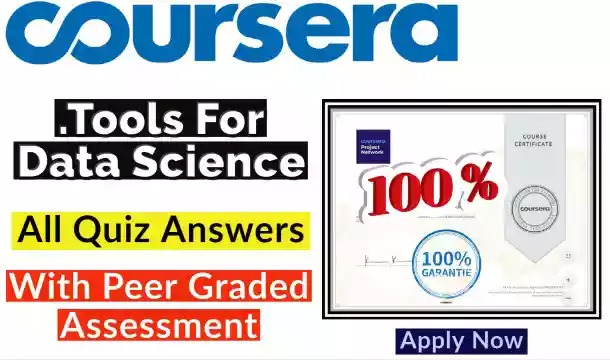In this blog you will find the correct answer of the Coursera quiz Finance for Everyone Decisions Coursera All Weeks Quizes mixsaver always try to bring the best blogs and best coupon codes
Week- 1
Making a Difference 1
|
submit the link to the tweet or post you’ve written this week |
Week- 2
Time Value of Money I
1. The present value of future cash flows increases if:
I. the interest rate decreases
II. the amounts occur closer to time zero
III. the compounding frequency increases
IV. the risk premium increases
- A) I & II only
- B) II & III only
- C) III & IV only
- D) I, II & III only
2. You invested $1,000 today at 4% compounded annually. How much interest was earned in year 5?
- A) $40.00
- B) $46.79
- C) $200.00
- D) $216.65
3. If a rate of return (r) and a time period (t) are greater than zero, then the:
I. Present value interest factors are less than one
II. Future value interest factors are less than one
III. Present value interest factors are greater than future value interest factors
IV. Present value interest factors grow as t grows, provided r is held consta
- A) I only
- B) I & II only
- C) I & IV only
- D) II & III only
- E) II & IV only
4. Grandma’s life savings of $100,000 earn 4% in a trust fund. You can’t withdraw the money until the amount has doubled.
How long will you have to wait until you can withdraw funds? Round off to the nearest year:
- A) 15 years
- B) 16 years
- C) 17 years
- D) 18 years
- E) 20 years
5. Beginners luck earned you $1,500 at the Casino when you were 26 years old. You used the $1,500 to buy shares in a 3D printing start-up company, which are worth $57,785.58 today.
If you are 57 years old today, what is your average annual rate of return? (Hint, what is the annual compounded interest rate?)
- A) 12.00%
- B) 12.08%
- C) 12.50%
- D) 12.94%
- E) None of the above
6. Suppose the nominal rate based is 7%, which is compounded monthly. Assuming the same effective rate of interest, what is the nominal rate based on quarterly compounding?
- A) 7.00%
- B) 7.04%
- C) 7.09%
- D) 7.22%
- E) 7.49
PRACTICE QUIZ
Using Your Financial Calculator
1. If you invest $1,000 in a savings account earning 8% per year, how much will you have after 5 years?
- $1,469.33
- $1,000
- $1,040
- $1,500
- $1,694.33
2. What is the present value of saving $2,000 every year for 15 years at an interest rate of 12%?
- $13,621.73
- $14,621.73
- $30,000
- $13,216.73
3. What is the present value of saving $2,000 every year for 15 years at an interest rate of 12%? What is the amount if the savings were made at the beginning of every year?
- $15,256.34
- $14,621.73
- $30,000
- $13,621.73
4. How much would you have to deposit into your savings account per month if you earn 10% per annum, with monthly compounding, if you want to have $1,000,000 in the bank after 5 years?
- $12,913.71
- $12,000
- $329.51
- $16,530
Making a Difference 2
|
submit the link to the tweet or post you’ve written this week |
week- 3
Money Flows
1. Financial decisions:
I. are about two kinds of money: your money (debt) and my money (equity)
II. are about allocating money for its most productive use
III. are motivated by greed
IV. ultimately lead to a crisis
- A) I only
- B) I & II only
- C) III & IV only
- D) I, II & III only
- E) None of the above
2. Which markets differentiate securities according to their maturity?
- A) Primary versus secondary
- B) Money versus capital
- C) Debt versus equity
- D) Auction versus dealer
- E) Money versus capital AND debt versus equity
3. What is the ultimate financial goal of the firm?
- A) To maximize profits
- B) To maximize earnings per share
- C) To maximize the interests of all stakeholders
- D) To maximize the price of the shares
- E) To maximize its social responsibility
4. Some of the repercussions of free and unregulated markets include:
- A) High unemployment, inflation and interest rates
- B) Inequity and wealth concentrated for the few
- C) Overextended Debt markets
- D) High unemployment, inflation and interest rates AND inequity and wealth concentrated for the few
- E) Inequity and wealth concentrated for the few AND overextended Debt markets
5. The most important predictor of a market crash is:
- A) High unemployment, inflation and interest rates
- B) Inequity and wealth concentrated for the few
- C) Overextended Debt markets
- D) High unemployment, inflation and interest rates AND inequity and wealth concentrated for the few
- Inequity and wealth concentrated for the few AND overextended Debt markets
Making a Difference 3
|
submit the link to the tweet or post you’ve written this week |
Time Value of Money II
1. An annuity due is a series of:
- A) Unequal beginning of period amounts for a set period of time
- B) Equal beginning of period amounts for a set period of time
- C) Equal beginning of period amounts that continue forever.
- D) Equal payments that occur at the end of each time period and continue forever
- E) None of the above
2. Which of the following cannot be calculated?
- A) The present value of a perpetuity
- B) The interest rate of a perpetuity, given its present value and amounts
- C) The future value of a perpetuity
- D) The present value of an annuity due
- E) The future value of an ordinary annuity
3. If the value today (t=0) of the future amounts below is $5,979.09 at 12%, what is the value of the missing (t=2) amount?
- A) $979.09
- B) $1,691
- C) $2,392
- D) $3,000
- E) None of the above
4. You’re excited to buy furniture worth $5,000, which you can pay back in 3 years in 36 equal monthly installments with the first payment due today. The interest rate is 9% compounded monthly. What are your monthly payments?
- A) $138.89
- B) $151.39
- C) $158.99
- D) $1,666.67
- E) $1,816.67
5. To have one million dollars when you retire in 35 years, how much will you need to deposit every two weeks assuming a12% interest rate?
- A) About $42
- B) About $56
- C) About $67
- D) About $71
- E) About $73
6. To settle a credit card debt of $1,250, you’ve agreed to pay $110 at the end of each month for the next year. What rate of interest are you paying?
- A) 10.18%
- B) 10.40%
- C) 10.67%
- D) 12.33%
- E) 5.60%
Week- 4
Peer-graded Assignment: “Op-Ed” Assignment
Project Title *
Give your project a descriptive title
|
“Op-Ed” Assignment |
Click here to download the assignment file
Final Quiz – Graded
1. If your $10 investment increases to $11 in 6 months, you would have earned the following annual rate of return:
- A) 1%
- B) 2%
- C) 10%
- D) 12%
- E) 20%
2. The present value of future cash flows increases if _________________.
I/ the interest rate decreases
II/ the amounts occur closer to time zero
III/ the compounding frequency increases
IV/ the risk premium increases
- A) I and II only
- B) II and III only
- C) III and IV only
- D) I, II and III only
- E) All of the above
3. You invested $1,000 today at 4%. How much interest was earned in year 5?
- A) $40.00
- B) $46.79
- C) $200.00
- D) $216.65
- E) None of the above
4. Thanks to your new diet, you are eating healthy and saving $10 a day during your 5 workday-week. You decide to set this aside as a future retirement dividend by depositing $50 every Friday in a fund for each of your remaining working years (45 years). Assume you can earn an average return of 10% over this period, what will be the future value of your investments the day you retire?
- A) 117,000
- B) $460,087
- C) $1,869,152
- D) $2,304,353
- E) None of the above
5. Present value the following cash prizes: (1) $150 annually forever or (2) $100 every six months over the next 25 years. The rate of interest is 6% compounded semi-annually.
- A) $2,463.05; $1,278.33
- B) $2,463.05; $2,572.97
- C) $2,500; $2,500
- D) $2,500; $2,556.67
- E) None of the above
6. You borrow $100 from “Jaw Breaker Joe” and promise to repay Joe a total of $105 in one month. What is the effective annual interest rate charged by Joe?
- A) 5.00%
- B) 60.00%
- C) 79.59%
- D) 179.59%





